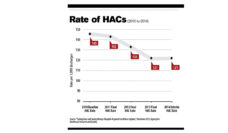A patient’s heart stops, bells ring, and a specialized team runs into the hospital room to begin chest compressions, electrical shocks and medications. This is a resuscitation, or ‘code blue’ event, and it happens up to 30 times per month at our hospital. The response team is an interprofessional group of critical care clinicians trained to save lives and maneuver patients throughout the hospital. For many years, our hospital has had an additional team member responding to code blue events — the chaplain. Our experience together told us that the chaplain’s presence was important and valuable to patients, families, and staff. But we wanted to better define the role. The best way to quantify the chaplains’ efforts was to explore nine years of their daily code blue response documentation.
Our findings confirm that chaplains indeed provided a wide variety of services to patients’ families before, during, and after resuscitations. They responded to code blue events quickly, usually within 5 minutes. They supported families with prayer, calming presence, and provided advocacy for the family and staff. Chaplains documented their involvement in resuscitation debriefing, supporting weary staff, and providing longitudinal care for all of those involved in code blue events. Chaplains served as intermediaries between the team and the family and supported the families by hosting them in the unfamiliar setting of the hospital.
We found that chaplains frequently cared for the clinical staff members of the code blue team. At 11% of code blue responses, chaplains provided care for nurses, physicians, and clinical staff members. This care involved highlighting the patient’s humanity and honoring the staff’s efforts for the patient in a moment of reflection, or ‘pause’ when the resuscitation ended in death. The prevalence and value of the contribution of chaplains is well-recognized by inter-professional health care workers, but is less well known by the public and has not been objectively demonstrated in the literature until now.
It is important for families to have the opportunity to be with their loved ones in the resuscitation space if they wish to observe.
We also found that family members were present at 53% of code blue events and many choose to observe the team’s efforts resuscitating their loved one. Family’s presence during resuscitation, if desired, can improve communication with the healthcare team and may lessen complicated grieving. Often, witnessing the resuscitation efforts reassures family that everything possible was done to care for the patient. Such observations are only safe and beneficial if there is someone prepared to facilitate their presence and safety. As spiritual care experts, chaplains are trained to support people in crisis by exploring the emotional, spiritual, and existential challenges they may be facing; chaplains are careful to invite each person to engage their own spiritual resources during a crisis rather than promote their own.
It is important for families to have the opportunity to be with their loved ones in the resuscitation space if they wish to observe. This is just one of many reasons why health systems should highlight and acknowledge the chaplain’s role as essential. Chaplains as family facilitators should be available at all times to provide a consistent and standardized response that augments the efforts of the code blue team. These sentiments inspired us to create a process by which families can choose to be present with their loved one at every code blue when appropriate.
Overall, we found chaplains to be a critical resource for the code blue team clinicians as they grappled with the realities of life and death on a daily basis. Our findings led us to appreciate the breadth and depth of care that chaplains offer to patients and their families during a code blue event. The pandemic and isolation of the critically ill from Covid-19 has made it abundantly clear that patients need to be with their loved ones during illness, particularly at the end of life. Incorporating healthcare chaplains into inter-professional code blue teams can be a part of the solution.
Photo via Getty Images
















